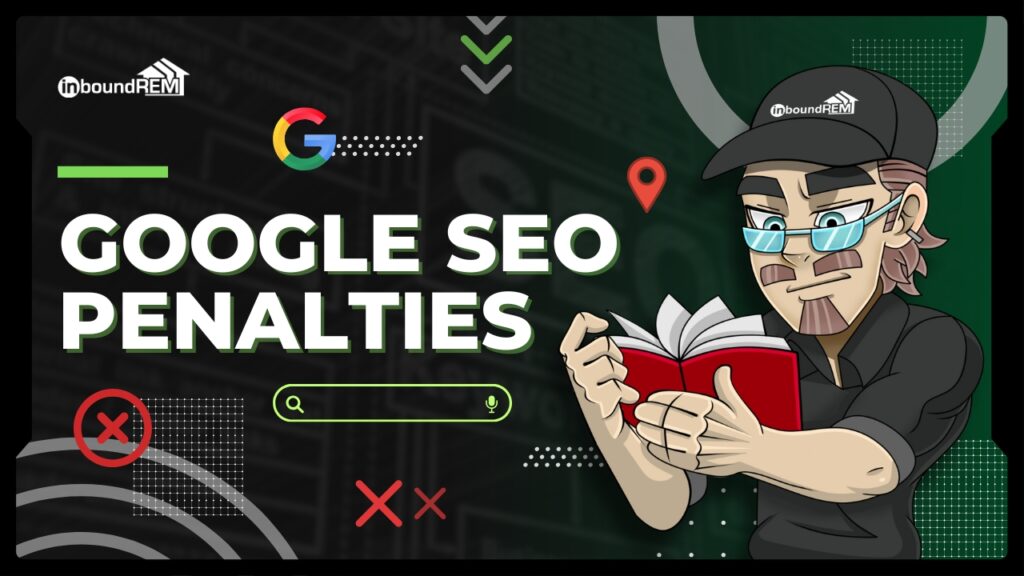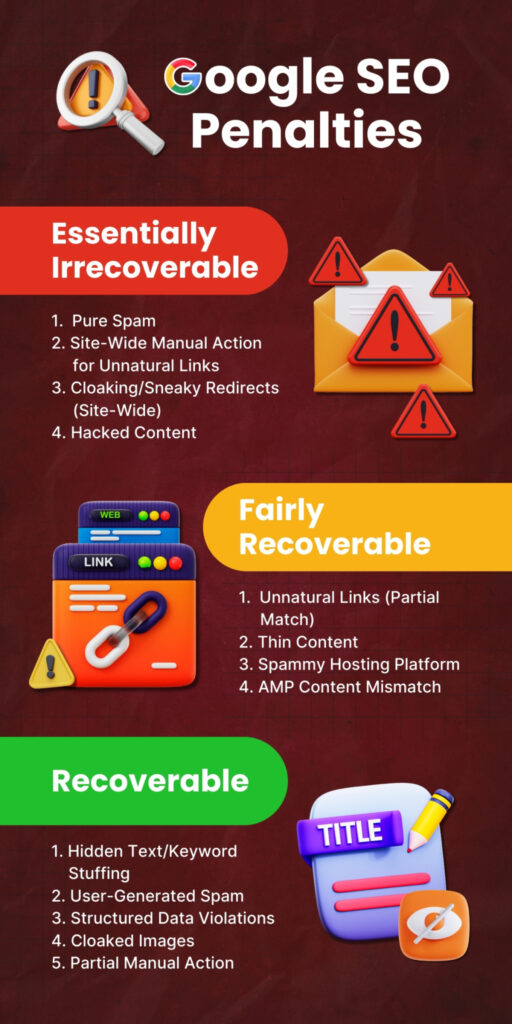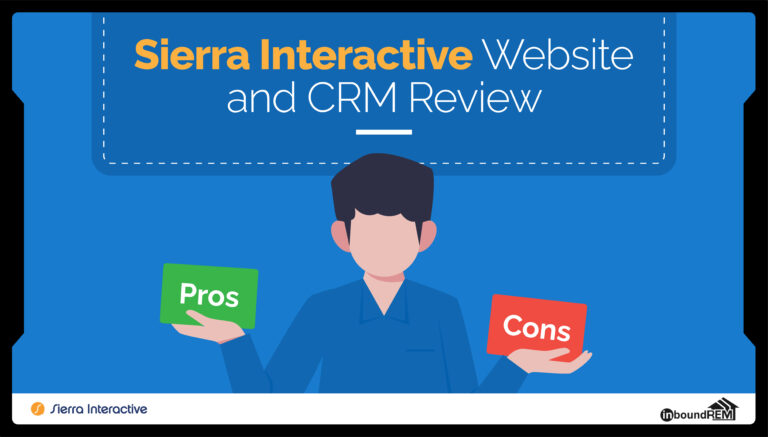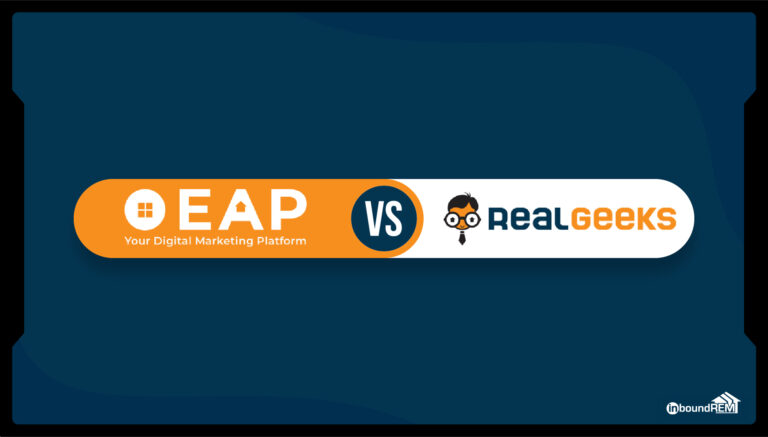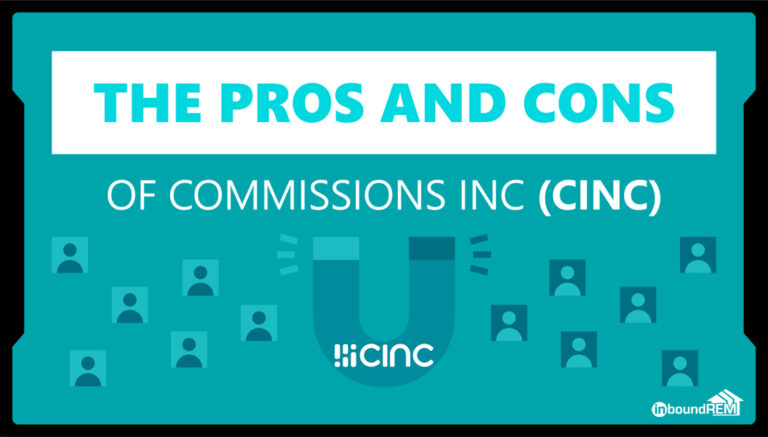Don’t Let SEO Penalties Cause Panic
Experiencing a sudden drop in your website’s search rankings can be alarming. First, avoid panic.
One of three things is happening. Either you got a manual penalty, an algorithmic penalty, or you just had a high-traffic page or keyword set fall off.
In most cases, the issue can be repaired. In some cases, there isn’t actually an issue. For example, check out this huge drop in our keywords.
At first, I was alarmed. All my hard work was flying out the window.
But traffic was actually on the rise. And all of our lost keywords were in Ranks 51+.
Upon closer inspection of lost keywords, the most recent Core Update seems to have retooled its definitions of keyword relevancy.
In other words, we lost a bunch of keywords that didn’t matter to us. Google cut off the fat. It looks bad on paper, but we now have less inflated, empty data skewing our metrics.
For you, it’s important to analyze if you ever deserved your lost traffic in the first place. Maybe you didn’t do anything wrong, it’s just that the algorithm righted itself. Ultimately, that’s good news.
This is why tools like Ahrefs or SEMrush are essential if you take organic traffic seriously. It’s harder to analyze situations like this with just Google Search Console or Google Analytics.
Now let’s assume you’re losing valuable traffic and keywords. The first step is knowing if the Google SEO penalty is manual or algorithmic.
Manual vs Algorithmic SEO Penalties
Manual Penalties
Manual penalties occur when a human reviewer at Google determines that your site violates Google’s Webmaster Guidelines. These penalties are typically communicated through the Manual Actions report in Google Search Console.
Common reasons include unnatural backlinks, thin content, or cloaking. Later we rank most possible Google SEO penalties by how repairable they are.
Following Google’s penalty advice, you can assess the cause and take corrective actions, such as disavowing links, removing thin content, or improving overall site quality.
Algorithmic Penalties
Algorithmic penalties, on the other hand, are automated and result from updates to Google’s search algorithms, such as Panda or Penguin.
These penalties aren’t explicitly communicated, making them harder to detect. A sudden drop in traffic often coincides with the rollout of a known algorithm update.
Tools like AHrefs show you on the traffic and keywords graphs exactly when minor and core updates occur. It’s super handy for comparing with your data.
You can also use a Google Core Update History page to see when they occur and how long they take to roll out.
Identifying the Type of Penalty
To determine whether you’ve been affected by a manual or algorithmic penalty:
- Check Google Search Console: Look for any manual action notifications under the Manual Actions section.
- Analyze Traffic Patterns: Use tools like Google Analytics to identify sudden drops in traffic. If a decline aligns with 1-6 weeks of Core algorithm updates, it may indicate an algorithmic penalty.
- Utilize Penalty Checker Tools: Platforms like Semrush Sensor track daily fluctuations in Google’s search results and can help detect potential penalties.
Google SEO Penalties Ranked (Worst to Best)
Google always reports manual SEO penalties on Google Search Console under “Manual Actions” in the sidebar. Not all manual penalties are equal, so I have divided them into sections:
Essentially Irrecoverable
- Pure Spam
- Site-Wide Manual Action for Unnatural Links
- Cloaking/Sneaky Redirects (Site-Wide)
- Hacked Content
Fairly Recoverable
- Unnatural Links (Partial Match)
- Thin Content
- Spammy Hosting Platform
- AMP Content Mismatch
Recoverable
- Hidden Text/Keyword Stuffing
- User-Generated Spam
- Structured Data Violations
- Cloaked Images
- Partial Manual Action
Should I Try Recovery or Start Over?
Google penalties can be devastating, especially those I consider “irrecoverable.” To be clear, saying that is my opinion. Technically all domains may be eventually recoverable. It’s just often not worth the effort and money for the most egregious of SEO penalties.
These penalties, like site-wide manual actions or pure spam penalties, severely impact your website’s visibility, often removing it entirely from search results. While labeled as “irrecoverable,” recovery is not always impossible—but it demands extraordinary effort, resources, and time.
The decision to recover or start fresh depends on how much traffic and backlinks you had and how much you lost.
If your site had less than 10k monthly visitors, less than 250 Root Domain backlinks, then I might cautiously suggest you should abandon ship if you’ve had any of my “Irrecoverable” Google SEO Penalties.
- Assess the Damage:
- Use tools like Google Search Console to identify which pages or site sections are affected.
- Evaluate the penalty’s impact on traffic and rankings. If organic traffic has dropped to near-zero levels and backlinks are primarily from low-quality sources, starting over may be the better choice.
- Measure Lost Backlinks:
- High-quality backlinks are valuable assets. Use tools like Ahrefs or SEMrush to determine whether your backlink profile is salvageable. If most links are toxic or disavowed, a fresh domain might be more efficient.
- Factor in Your Content:
- If your site has a wealth of original, high-quality content unaffected by the penalty, you can salvage and repurpose it for a new domain.
What Can Be Salvaged?
Even when a site is penalized beyond recovery, you don’t have to abandon everything. Here’s what you can preserve:
- High-Quality Content: Identify pages offering real value and optimize them for a new domain.
- Branding Elements: Logos, color schemes, and design elements can transfer seamlessly.
- Customer Data: Maintain your email lists, CRM, and social media audiences to rebuild on a new platform.
- Performance Insights: Use historical data to understand what worked before the penalty and replicate successful strategies.
Key Decision-Making Factors
Deciding whether to recover or start fresh hinges on three factors:
- Traffic Impact: If your traffic loss is limited to specific pages, recovery is viable. Total de-indexation might warrant starting anew.
- Backlink Profile: A strong, clean backlink profile favors recovery. Toxic links suggest starting over.
- Effort and Cost: Recovery is labor-intensive and can take months. A fresh start might save resources in the long term.
What to Do If You Start Over
If you choose to rebuild:
- Audit and Improve Salvaged Content: Enhance content to align with Google’s current guidelines.
- Establish a Clean Backlink Profile: Focus on natural, high-quality backlinks from day one.
- Implement Strong Security and Compliance: Avoid spammy practices and invest in robust monitoring tools.
Proactive Measures to Avoid Future Penalties
Regardless of whether you recover or rebuild, follow these proactive strategies:
- Conduct regular SEO audits using tools like Screaming Frog or Sitebulb.
- Monitor backlinks and disavow toxic links promptly.
- Stay updated on Google’s Webmaster Guidelines to ensure compliance.
Next, we’ll explore individual “irrecoverable” penalties, detailing case studies, step-by-step recovery plans (if applicable), and advice for salvaging and rebuilding.
"Irrecoverable" Google Penalties
Let’s examine the most severe penalties that often lead webmasters to consider starting fresh.
For each penalty, I’ll provide detailed explanations and actionable steps for recovery or transitioning to a new domain.
1. Pure Spam Penalty
What It Is
This penalty is issued when Google identifies a site as engaging in egregious spam tactics, such as auto-generated content, scraped material, or manipulative practices. A Pure Spam penalty typically results in site-wide de-indexation.
Step-by-Step Guide to Recovery
- Audit Your Content
- Use tools like Screaming Frog or Ahrefs Site Audit to identify spammy, low-quality, or auto-generated pages.
- Remove or rewrite content to meet Google’s quality standards.
- Rebuild Trust
- Add detailed About pages, author bios, and clear contact information to show authenticity.
- Cite reliable sources in your content.
- Disavow Toxic Links
- Use Google’s Disavow Tool to address spammy backlinks pointing to your site.
- Submit a Reconsideration Request
- Provide a clear, honest explanation of the changes made.
- Include evidence, such as screenshots or updated content links.
If Recovery Fails
- Salvage high-value content and assets, and move them to a new domain.
- Focus on establishing trust from day one by building high-quality, user-focused pages.
2. Site-Wide Manual Action for Unnatural Links
What It Is
Google applies this penalty when it identifies excessive or manipulative backlink practices. This includes link schemes, paid links, or participation in private blog networks (PBNs).
Step-by-Step Guide to Recovery
- Audit Your Backlink Profile
- Use Ahrefs or SEMrush to identify backlinks with low Domain Rating (DR) or suspicious anchor texts. Another great tool is SEOjet.
- Request Link Removal
- Reach out to site owners and request link removal. Prioritize high-impact toxic links.
- Disavow Remaining Links
- Create a disavow file for links you cannot remove and upload it to Google Search Console.
- Focus on Organic Link Building
- Publish guest posts, collaborate with influencers, and create shareable, high-quality content. Use HARO-style sites for free, high-value, and whitehat links.
- Submit a Reconsideration Request
- Include a detailed explanation of your efforts, a clean backlink profile, and evidence of outreach.
3. Cloaking and Sneaky Redirects (Site-Wide)
What It Is
This penalty is issued when Google finds that a website is serving different content to search engines than to users or redirects users to unexpected destinations.
Step-by-Step Guide to Recovery
- Audit Your Backlink Profile
- Use Ahrefs or SEMrush to identify backlinks with low Domain Rating (DR) or suspicious anchor texts. Another great tool is SEOjet.
- Request Link Removal
- Reach out to site owners and request link removal. Prioritize high-impact toxic links.
- Disavow Remaining Links
- Create a disavow file for links you cannot remove and upload it to Google Search Console.
- Focus on Organic Link Building
- Publish guest posts, collaborate with influencers, and create shareable, high-quality content. Use HARO-style sites for free, high-value, and whitehat links.
- Submit a Reconsideration Request
- Include a detailed explanation of your efforts, a clean backlink profile, and evidence of outreach.
4. Hacked Content Penalty
What It Is
Issued when Google detects that a site has been compromised by hackers and is hosting malicious or spammy content. This can lead to de-indexation and loss of trust.
Step-by-Step Guide to Recovery
- Identify the Breach
- Use security tools like Sucuri or Wordfence to scan for malware and vulnerabilities.
- Clean the Site
- Remove malicious code and restore affected files from backups.
- Secure the Site
- Implement HTTPS, enable two-factor authentication (2FA), and install a firewall.
- Request a Security Review
- Use Google Search Console’s “Request Review” feature after securing the site.
- Rebuild Trust
- Publish a transparent statement about the issue and steps taken to resolve it.
Fairly Recoverable Google SEO Penalties
1. Unnatural Links (Partial Match) Penalty
What It Is
A partial match unnatural links penalty occurs when Google detects manipulative or low-quality backlinks pointing to specific sections of your website. Unlike site-wide penalties, this action affects only the flagged pages or subdomains, sparing the rest of the site.
Step-by-Step Recovery Guide
- Audit Your Backlink Profile
- Use tools like Ahrefs, SEMrush, or Moz to analyze backlinks.
- Focus on identifying links with these characteristics:
- Low Domain Rating (DR) or Domain Authority (DA).
- Spammy or irrelevant anchor texts.
- Links from unrelated or suspicious domains (e.g., gambling or adult content sites).
- Contact Webmasters
- For each toxic backlink, reach out to the site owner or webmaster with a polite request for link removal.
- Example email:
Subject: Request for Link Removal
Hi [Site Owner],
I’ve noticed a link from your site ([link URL]) pointing to my page ([your page URL]). While I appreciate the connection, I believe this link may not align with current SEO best practices. Would you kindly remove it?
Thanks in advance,
[Your Name]
The name of the game here is highly organized and persistent efforts. Try to avoid the disavowal tool as much as you can. It can cause more complications than desirable.
- Disavow Remaining Links
- For links that cannot be removed, create a disavow file:
- Format: domain:example.com.
- Upload the file via Google Search Console under the Disavow Links Tool.
- Be cautious—only disavow links you are certain are harmful.
- For links that cannot be removed, create a disavow file:
- Build High-Quality Backlinks
- Replace lost backlinks with reputable, organic ones:
- Publish guest posts on industry-relevant blogs.
- Collaborate with influencers or partners for co-branded content.
- Create shareable content, such as infographics or case studies.
- Replace lost backlinks with reputable, organic ones:
- Submit a Reconsideration Request
- Craft a detailed explanation of your cleanup efforts:
- Describe the tools used for the audit.
- Provide evidence of outreach attempts (e.g., screenshots or emails).
- Highlight steps taken to avoid future issues, such as backlink monitoring plans.
- Submit the request via Google Search Console.
- Craft a detailed explanation of your cleanup efforts:
Insights from Experts
Marie Haynes (SEO Consultant):
“The key to recovering from unnatural links penalties is transparency in your reconsideration request. Google wants to see you’ve taken proactive steps to fix the issue and prevent it from happening again.” (Source).
Ahrefs Study:
“Sites that disavowed toxic links and simultaneously built new, high-quality backlinks saw faster recovery compared to those who only disavowed links.” (Source).
With persistence and a methodical approach, recovering from a partial match unnatural links penalty is possible. While it may take months, the effort to regain rankings and prevent future penalties is well worth it.
2. Thin Content Penalty
What It Is:
The thin content penalty is applied when Google identifies pages with little or no added value.
This includes content that is poorly written, duplicated, auto-generated, or created solely to manipulate rankings without providing substantial benefit to users.
Thin content penalties can affect individual pages, sections, or entire websites, depending on the severity.
Step-by-Step Recovery Guide
- Audit Your Content
- Use tools like Screaming Frog, Siteliner, or ContentKing to identify:
- Pages with low word counts (e.g., less than 300 words).
- Duplicate or syndicated content.
- Auto-generated or poorly written text.
- Use tools like Screaming Frog, Siteliner, or ContentKing to identify:
- Categorize Problematic Content
- Rewrite: For pages with potential, expand content with:
- In-depth explanations, examples, and case studies.
- FAQs addressing user questions.
- Relevant multimedia like images, infographics, or videos.
- Merge: Combine multiple thin pages covering similar topics into one comprehensive page.
- Remove or Noindex: For pages with no value or potential, delete them or set them to noindex to prevent them from appearing in search results.
- Rewrite: For pages with potential, expand content with:
- Follow Google’s Content Guidelines
- Ensure all content aligns with Google’s Search Quality Evaluator Guidelines.
- Focus on E-A-T (Expertise, Authoritativeness, Trustworthiness):
- Add author bios for credibility.
- Cite reputable sources and include outbound links.
- Use Structured Data
- Enhance content with schema markup to improve its discoverability in search results. Examples include FAQ schema, how-to schema, or product schema.
- Submit a Reconsideration Request
- Prepare a detailed report documenting:
- The steps taken to improve or remove thin content.
- Screenshots of rewritten pages.
- A list of removed or consolidated URLs.
- Submit the request in Google Search Console.
- Prepare a detailed report documenting:
Insights from Experts
John Mueller (Google Search Advocate):
“Removing thin content and focusing on creating original, helpful content is crucial for long-term success. Even small improvements over time can make a big difference.” (Source)
Neil Patel (SEO Expert):
“If your site has a thin content penalty, rewriting and consolidating content not only helps with rankings but also improves user engagement metrics, which Google values highly.” (Source)
Additional Tips
- Use free tools like Google Trends to identify relevant topics that align with user interests.
- Develop a content calendar to ensure consistent publishing of high-quality material.
- Encourage user engagement by adding comment sections, polls, or feedback forms to pages.
3. Spammy Free Host Penalty
What It Is
This penalty targets free hosting services that allow spammy or low-quality sites to proliferate on their platforms.
While aimed at the hosting provider, individual sites using the service may also be impacted. Google applies this penalty to reduce spam content in search results, as it deems the hosting environment unreliable.
Step-by-Step Recovery Guide
- Verify the Penalty in Google Search Console
- Navigate to the Manual Actions section to confirm the penalty and its scope.
- Migrate to a Reputable Hosting Service
- Select a trusted hosting provider with robust security measures and strict anti-spam policies, such as SiteGround, Bluehost, or WP Engine.
- Back up your site and migrate it to the new host, ensuring all files and databases transfer correctly.
- Secure Your Site Against Spam
- Install security tools like Sucuri or Wordfence to protect against spam bots and malicious activity.
- Implement CAPTCHA or reCAPTCHA for user registrations and form submissions.
- Clean Up Third-Party Spam
- Audit your site for spammy user-generated content, such as:
- Irrelevant forum posts.
- Low-value comments with promotional links.
- Remove or noindex pages that add no value to users or violate Google’s guidelines.
- Audit your site for spammy user-generated content, such as:
- Submit a Reconsideration Request
- Provide a detailed explanation of your site migration, highlighting your shift to a reputable hosting provider.
- Include evidence of anti-spam measures implemented on your site (e.g., screenshots of security tools or CAPTCHA-enabled forms).
Proactive Measures for the Future
- Choose Trusted Hosting: Avoid free hosting platforms that lack robust spam management systems.
- Moderate User-Generated Content: Assign moderators for forums, comments, and user profiles to ensure quality.
- Establish a Spam Policy: Create clear rules for acceptable content and enforce them consistently.
- Monitor Hosting Reputation: Use tools like Hosting Checker to track the reputation of your hosting service.
Insights from Experts
Matt Cutts (Former Google Search Team):
“Free hosting services often attract spammers, which is why Google takes a close look at sites hosted on them. If you’re running a legitimate site, switching to a paid host can make a huge difference in trust.” (Source)
Moz Blog:
“Migrating to a reliable host is the fastest way to overcome a spammy free host penalty. Pair this with stringent content moderation to future-proof your site.” (Source)
Additional Tips
- After migrating, update your DNS settings and ensure proper redirects to maintain traffic and rankings.
- Use hosting providers that offer integrated spam management tools, such as Akismet for WordPress.
- Communicate the hosting change to your audience to maintain trust and transparency.
4. AMP Content Mismatch Penalty
What It Is
An AMP Content Mismatch penalty occurs when the Accelerated Mobile Pages (AMP) version of a webpage doesn’t match its standard desktop version.
This inconsistency can include differences in text, images, or functionality, misleading users and reducing trust in AMP content. While this penalty affects AMP results, it can indirectly impact mobile rankings and traffic.
Step-by-Step Recovery Guide
- Identify Affected Pages
- Use Google Search Console to find the flagged AMP pages under the “AMP” or “Manual Actions” section.
- Look for errors like missing text, images, or other discrepancies between AMP and desktop versions.
- Audit and Update AMP Pages
- Use the AMP Validator tool (https://validator.ampproject.org/) to identify and fix issues.
- Ensure that AMP pages include the same core content as the desktop versions:
- Text: All critical text elements should be identical.
- Images: Ensure images are optimized for mobile and match desktop visuals.
- Functionality: Interactive elements (e.g., forms or links) should work consistently across both versions.
- Revalidate AMP Pages
- After fixing discrepancies, revalidate AMP pages using tools like Google Search Console or the AMP Validator.
- Test User Experience
- Use tools like PageSpeed Insights or Lighthouse to ensure AMP pages load quickly and deliver a seamless user experience.
- Submit a Reconsideration Request
- Detail the actions taken to align AMP and desktop content.
- Provide screenshots or logs showing the corrected AMP pages and validation results.
Proactive Measures for the Future
- Use AMP Frameworks: Tools like AMP for WordPress can help automate the creation of consistent AMP pages.
- Monitor AMP Pages Regularly: Set a schedule for auditing AMP versions to catch potential discrepancies early.
- Leverage Responsive Design: If maintaining AMP pages is challenging, consider fully responsive design as an alternative for mobile optimization.
Insights from Experts
Barry Schwartz (SEO Industry Expert):
“The AMP Content Mismatch penalty often stems from poor implementation. Using automated tools and regularly validating pages can save you from hours of manual fixes later.” (Source)
Google Search Console Team:
“The AMP Validator is your first line of defense against mismatches. Addressing errors quickly ensures that AMP remains a trusted, fast experience for users.” (Source)
Additional Tips
- Include AMP pages in your XML sitemap for better indexing.
- Use structured data markup on AMP pages to improve visibility in search results.
- Regularly review AMP content guidelines from Google to stay updated on compliance requirements.
Full Recoverable Google SEO Penalties
1. Hidden Text/Keyword Stuffing Penalty
What It Is
This penalty is issued when Google detects hidden text on a website (e.g., white text on a white background) or excessive keyword stuffing to manipulate rankings. These practices are considered deceptive and provide a poor user experience.
Step-by-Step Recovery Guide
- Identify Problem Areas
- Use Google Search Console to check for flagged pages under “Manual Actions.”
- Crawl the site with tools like Screaming Frog or DeepCrawl to identify:
- Instances of hidden text (e.g., matching text and background colors).
- Overuse of keywords or unnatural repetition.
- Remove Hidden Text
- Inspect flagged pages for CSS styles that hide text or position it off-screen.
- Remove or restyle hidden text to make it visible, relevant, and user-focused.
- Rewrite Over-Optimized Content
- Rewrite pages with stuffed keywords to improve readability:
- Use variations of keywords (e.g., synonyms or long-tail phrases).
- Aim for natural language flow that prioritizes user intent.
- Rewrite pages with stuffed keywords to improve readability:
- Test for Compliance
- Use the Mobile-Friendly Test Tool or PageSpeed Insights to ensure text is visible across devices.
- Check for any lingering keyword overuse with tools like SEO Review Tools Keyword Density Checker.
- Submit a Reconsideration Request
- Detail the changes made, providing evidence of removed hidden text and updated content.
- Highlight your commitment to following Google’s guidelines moving forward.
Proactive Measures for the Future
- Write for Users, Not Bots: Focus on creating engaging, helpful content that naturally incorporates keywords.
- Use HTML and CSS Responsibly: Avoid CSS techniques that could unintentionally hide text.
- Regular Audits: Schedule regular SEO audits to detect issues before they result in penalties.
Insights from Experts
Rand Fishkin (Moz Founder):
“Keyword stuffing and hidden text may have worked in the early days of SEO, but today, they’ll get you penalized. Focus on matching user intent instead.” (Source)
Google Search Console Help:
“Hidden text designed to manipulate search rankings violates our guidelines. We encourage site owners to ensure all content is accessible to both users and search engines.” (Source)
Additional Tips
- Use a text-to-background color contrast checker to ensure compliance.
- Avoid over-optimization by focusing on user intent and quality content.
- Train your content team to spot and avoid outdated black-hat SEO tactics.
2. Structured Data Violations Penalty
What It Is
A Structured Data Violations penalty is issued when Google detects that a website’s schema markup (structured data) is misleading, inaccurate, or non-compliant with Google’s structured data guidelines.
Common violations include using schema markup for content not visible to users, misrepresenting content, or spamming schema fields to manipulate search rankings.
Step-by-Step Recovery Guide
- Audit Structured Data
- Use Google Search Console to identify errors flagged under the “Enhancements” or “Manual Actions” sections.
- Run your site through the Rich Results Test (https://search.google.com/test/rich-results) or Schema.org Validator to check for:
- Schema markup applied to irrelevant or invisible content.
- Incorrect fields (e.g., assigning a “five-star rating” without actual user reviews).
- Overuse of spammy keywords in schema fields.
- Remove or Correct Problematic Schema
- Fix schema fields that don’t comply with Google’s guidelines:
- Remove fake reviews or ratings from the Review schema.
- Correct misleading product information in Product schema.
- Delete schema markup for non-applicable elements (e.g., applying FAQ schema to unrelated pages).
- Fix schema fields that don’t comply with Google’s guidelines:
- Test for Compliance
- Use the Rich Results Test Tool to verify that structured data is properly implemented and error-free.
- Check for consistency between the visible content and the structured data.
- Update Your Sitemap
- Regenerate and submit your XML sitemap in Google Search Console to ensure re-indexing of corrected pages.
- Submit a Reconsideration Request
- Prepare a detailed explanation of the errors fixed, including screenshots of updated schema and validator test results.
- Submit the request in Google Search Console under the “Manual Actions” section.
Insights from Experts
Barry Schwartz (SEO Industry Expert):
“Structured data enhances visibility, but misuse can lead to penalties. Always ensure your schema reflects real user-visible content to avoid being flagged.” (Source)
John Mueller (Google Search Advocate):
“Structured data is a powerful tool for improving search appearance, but it needs to be accurate and transparent. Misleading markup doesn’t just hurt your rankings—it can also erode user trust.” (Source)
Additional Tips
- Avoid “review stuffing” by adding legitimate user reviews only.
- Use automated tools like Yoast SEO or RankMath for WordPress to simplify schema implementation.
- Monitor search result enhancements regularly in Google Search Console to track the health of your structured data.
3. Cloaked Images Penalty
What It Is
A Cloaked Images penalty occurs when Google detects that a website displays different images to search engine crawlers and users.
This can include serving low-quality images to users while showing high-quality versions to crawlers or obscuring images in ways that manipulate search results.
Cloaking images violates Google’s Webmaster Guidelines because it misleads both search engines and users.
Step-by-Step Recovery Guide
- Identify Cloaked Images
- Use Google Search Console to locate flagged URLs in the “Manual Actions” section.
- Crawl the site using tools like Screaming Frog to identify discrepancies in how images are served to crawlers versus users.
- Remove Cloaking Scripts
- Check your site’s HTML, CSS, or JavaScript for code that:
- Hides or replaces images for users but serves optimized versions to crawlers.
- Uses dynamic image rendering based on user-agent detection.
- Remove or modify these scripts to ensure consistency.
- Check your site’s HTML, CSS, or JavaScript for code that:
- Replace Low-Quality Images
- Ensure all images displayed to users are of high quality and match the search intent.
- Optimize images for both users and crawlers using tools like TinyPNG or ImageOptim to compress without quality loss.
- Verify Compliance
- Use Google’s Mobile-Friendly Test and Rich Results Test tools to ensure images appear the same across devices and to both users and crawlers.
- Perform manual checks on critical pages by inspecting them with a browser’s developer tools (e.g., Chrome DevTools).
- Submit a Reconsideration Request
- Include a detailed summary of the changes made, highlighting:
- The removal of cloaking scripts.
- Examples of updated, user-visible images.
- Results from testing tools that confirm compliance.
- Include a detailed summary of the changes made, highlighting:
Insights from Experts
Danny Sullivan (Google Search Liaison):
“Image cloaking is not a gray area—it’s a clear violation of our guidelines. Google wants users to have the same experience that the crawler does.” (Source)
Moz Blog:
“Cloaked images may offer short-term ranking benefits, but the penalties far outweigh any gains. Authentic, high-quality images are the best long-term strategy.” (Source)
Additional Tips
- Use the Lighthouse Performance Tool to identify slow-loading images that may tempt cloaking attempts.
- Ensure consistency between image metadata (e.g., filenames, alt text) and the actual image content.
- Regularly review and update your image optimization practices to align with Google’s latest guidelines.
4. Partial Manual Action Penalty
What It Is
A Partial Manual Action penalty affects specific pages, sections, or subdomains of a website instead of the entire site.
It is issued when Google detects violations of its Webmaster Guidelines, such as unnatural backlinks, thin content, or spammy user-generated material.
While less severe than site-wide penalties, partial manual actions can still significantly impact rankings and traffic for the affected areas.
Step-by-Step Recovery Guide
- Identify Affected Areas
- Check Google Search Console under the Manual Actions section to locate flagged pages or subdomains.
- Use tools like Ahrefs or SEMrush to identify problematic backlinks or content issues tied to the penalty.
- Address the Violation
- Unnatural Backlinks:
- Audit the affected backlinks using tools like Ahrefs or Google Search Console’s “Links” report.
- Request removal of spammy backlinks by contacting webmasters.
- Disavow remaining toxic links with Google’s Disavow Tool.
- Thin Content:
- Remove or rewrite flagged pages to include detailed, user-focused content.
- Merge redundant pages into comprehensive resources.
- Spammy User-Generated Content:
- Delete inappropriate or irrelevant user comments, posts, or profiles.
- Implement moderation tools like Akismet or CAPTCHA to prevent future spam.
- Unnatural Backlinks:
- Improve User Experience
- Optimize flagged pages for mobile-friendliness and speed using tools like Google’s PageSpeed Insights.
- Add E-A-T (Expertise, Authoritativeness, Trustworthiness) signals, such as author bios and external citations, to rebuild credibility.
- Submit a Reconsideration Request
- Include specific examples of the actions taken to address the issues, such as:
- Screenshots of removed or rewritten content.
- Evidence of backlink clean-up efforts, including emails or disavow files.
- Steps implemented to prevent recurrence (e.g., spam filters, improved moderation).
- Include specific examples of the actions taken to address the issues, such as:
- Monitor Recovery
- Use tools like Google Analytics and Search Console to track rankings and traffic for previously flagged pages.
- Continue to audit content and backlinks periodically to avoid future penalties.
Insights from Experts
Marie Haynes (SEO Consultant):
“Partial manual actions give you a second chance to fix specific issues without the devastating impact of a site-wide penalty. Focus your efforts on the flagged areas to rebuild trust with Google.” (Source)
Search Engine Journal:
“The best way to handle partial manual actions is to fix what’s broken and demonstrate to Google that you’ve implemented preventative measures for the future.” (Source)
Additional Tips
- Prioritize fixing the most critical issues first, such as harmful backlinks or duplicate content.
- Document every step of the recovery process to include in your reconsideration request.

